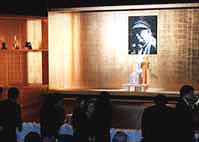|
Top Picks || Arts & Entertainment || Business & Economy || Education & Society ||
AKIRA KUROSAWA DIES: World Mourns the Passing of a Film Giant October 5, 1998  The Japanese film world turned out in force for the great director's funeral. (Jiji Press) Internationally renowned movie director Akira Kurosawa, whose many famous films have made history, died on September 6, 1998, of a stroke. He was 88. Kurosawa's film Rashomon was the first Japanese movie to capture a grand prix at an international film festival, catapulting him into instant fame as a world-class director. The many films credited to him throughout his lifetime have enjoyed great acclaim both in Japan and abroad, creating a lasting impression on the master filmmakers of the world and many others in the movie industry. Winner of Every Major International Film Award He continued to show his prowess with many other movies, which provided everything from entertainment to social critique. These movies include: Ikiru (1952), which took a deep and loving look at a man approaching death (winner of the Silver Bear Award for best picture at the 1952 Berlin International Film Festival); Shichinin no Samurai (Seven Samurai, 1954), which boldly portrayed a group of warriors protecting a village from bandits (winner of the Silver Lion Award at the 1954 Venice Film Festival); Kumonosu Jo (Throne of Blood, 1957), an adaptation of Shakespeare's Macbeth, which won awards in Lisbon, London, and Los Angeles; and Yojimbo (1961), a samurai action film in which a masterless warrior, who is an expert sword fighter, single-handedly crushes a gang of hoodlums. For a brief time, during the 1960s, Kurosawa's work enjoyed little public success in Japan. His fame rebounded, however, when his joint production with the Soviet Union, Dersu Uzala (1974), brought him his second Oscar for Best Foreign Film in 1975. His comeback was reinforced when he was honored as co-winner of the Palme d'Or (top prize) at the 1980 Cannes Film Festival for Kagemusha (1980), depicting Japan's feudal period of the sixteenth century--and the first samurai action film he had made in many years. Later added to his list of awards were the Japanese Order of Culture, bestowed on him in 1985, and the People's Honor Award, given posthumously in October 1998. A perfectionist on the set, Kurosawa would not stand for compromise. While shooting one movie, for example, he suspended the filming of a storm scene until an actual typhoon arrived. He set high standards for the film world with the clarity of his themes, his captivating plot development, and his stunning range of photographic technique. Kurosawa's last piece, Madadayo (1993), took a warm look at the special relationship between an essayist and his former university students. At over 80 years old, the tremendous passion that he poured into this film and the beauty of his vivid imagery won him acclaim from far and wide. Tremendous Influence on Filmmakers Worldwide At a ceremony held in Yokohama on September 13 to bid farewell to the great director, 35,000 movie industry figures and fans came to pay their respects. Numerous telegrams were received from well-known directors and other cinema people the world over. In his message, George Lucas praised Kurosawa's "true genius" and mastery of the art, noting the director's lasting influence on his own work, and stating, "The world has lost a rich treasure."
 Edited by Japan Echo Inc. based on domestic Japanese news sources. Articles presented here are offered for reference purposes and do not necessarily represent the policy or views of the Japanese Government. Edited by Japan Echo Inc. based on domestic Japanese news sources. Articles presented here are offered for reference purposes and do not necessarily represent the policy or views of the Japanese Government.
|
